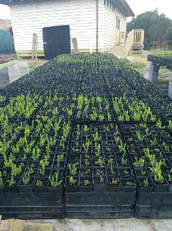
The Wonthaggi Seed Bank started with a few local farmers planting shelter belts. Today it's helping to revegetate hundreds of hectares of public land.
By Terri Allen
THE Wonthaggi Seed Bank had its genesis in Cape Paterson Coastal Plains Landcare. This group of dedicated farmers espoused the cause of indigenous plants for shelter belts, eradication of pest species, and experimentation with direct seeding methods and education.
Ably led by Landcare officer Geoff Trease, they made a difference to the local landscape. One group mapped and monitored roadside weeds and began to remove them. Farmers used chainsaws and utes to collect branches of indigenous plants; these branches were dried on sheets in sheds. Fallen seed on the sheets was dealt with in kitchens, cleaned, sorted and weighed. The use of Asquith’s old dairy was a godsend, a depot for collected seed, igloos to dry seed and a place to clean and sort seed. Direct seeding on members’ farms enabled research into and trialling of methods.
The seed bank soon became a separate entity, working with a group of seed banks under the auspices of the West Gippsland Catchment Management Authority to produce guidelines such as types of seed to be collected, amounts (10 per cent of a plant), permits needed, and the use and sale of seed.
A band of collectors met weekly. They learned about the plants, where they were located, how to collect, when to harvest. Another band dealt with the seed, drying, cleaning, weighing, storing. Some prepared the seed mixes for direct seeding.
As the value of public land and its protection was realised, these same people sought grants to revegetate, in conjunction with local environment groups such as the Friends of Wonthaggi Heathland and the South Gippsland Conservation Society.
Schools participated in the projects with seed collection, propagation and planting out. Some planting days fielded 300 planters.
Revegetation included planting of tube stock and direct seeding. Revegetation sites include Tent Town, the Wonthaggi Wetlands, Five Brace, Rifle Range, Wonthaggi Bushland Reserve, Tank Hill, Wonthaggi Heathland, Baxter’s Wetlands and West Area Block.
The Wonthaggi Seed Bank expanded in 2014 to include a nursery at the State Coal Mine. Here plants are propagated from locally collected indigenous seed. Volunteers work on Wednesdays and Fridays cleaning and sorting seed, sowing seed, pricking out, watering and caring for plant stock. Plants have been supplied to projects such as wetland refurbishment, Five Brace and West Area revegetation, Cape Paterson Residents and Ratepayers and South Gippsland Conservation Society projects.
To find out more about the Wonthaggi Seed Bank and Nursery, visit http://wsbn.org.au or email [email protected].
THE Wonthaggi Seed Bank had its genesis in Cape Paterson Coastal Plains Landcare. This group of dedicated farmers espoused the cause of indigenous plants for shelter belts, eradication of pest species, and experimentation with direct seeding methods and education.
Ably led by Landcare officer Geoff Trease, they made a difference to the local landscape. One group mapped and monitored roadside weeds and began to remove them. Farmers used chainsaws and utes to collect branches of indigenous plants; these branches were dried on sheets in sheds. Fallen seed on the sheets was dealt with in kitchens, cleaned, sorted and weighed. The use of Asquith’s old dairy was a godsend, a depot for collected seed, igloos to dry seed and a place to clean and sort seed. Direct seeding on members’ farms enabled research into and trialling of methods.
The seed bank soon became a separate entity, working with a group of seed banks under the auspices of the West Gippsland Catchment Management Authority to produce guidelines such as types of seed to be collected, amounts (10 per cent of a plant), permits needed, and the use and sale of seed.
A band of collectors met weekly. They learned about the plants, where they were located, how to collect, when to harvest. Another band dealt with the seed, drying, cleaning, weighing, storing. Some prepared the seed mixes for direct seeding.
As the value of public land and its protection was realised, these same people sought grants to revegetate, in conjunction with local environment groups such as the Friends of Wonthaggi Heathland and the South Gippsland Conservation Society.
Schools participated in the projects with seed collection, propagation and planting out. Some planting days fielded 300 planters.
Revegetation included planting of tube stock and direct seeding. Revegetation sites include Tent Town, the Wonthaggi Wetlands, Five Brace, Rifle Range, Wonthaggi Bushland Reserve, Tank Hill, Wonthaggi Heathland, Baxter’s Wetlands and West Area Block.
The Wonthaggi Seed Bank expanded in 2014 to include a nursery at the State Coal Mine. Here plants are propagated from locally collected indigenous seed. Volunteers work on Wednesdays and Fridays cleaning and sorting seed, sowing seed, pricking out, watering and caring for plant stock. Plants have been supplied to projects such as wetland refurbishment, Five Brace and West Area revegetation, Cape Paterson Residents and Ratepayers and South Gippsland Conservation Society projects.
To find out more about the Wonthaggi Seed Bank and Nursery, visit http://wsbn.org.au or email [email protected].